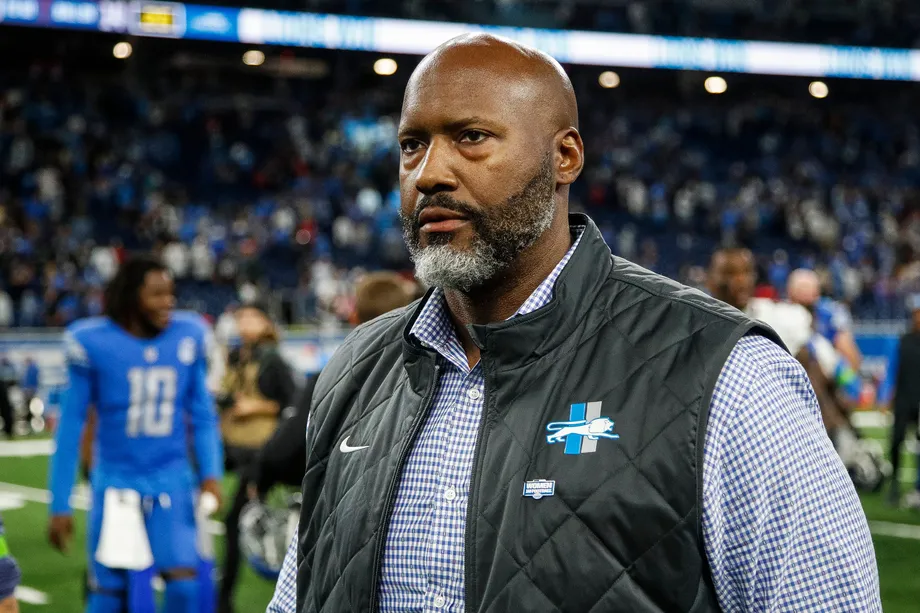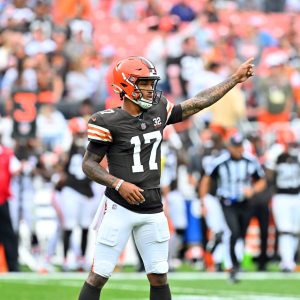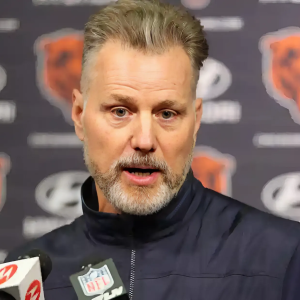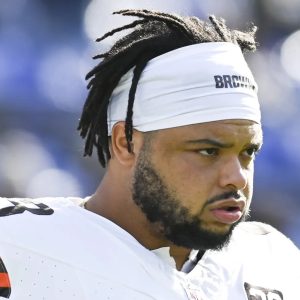I understand questioning anything Detroit Lions general manager Brad Holmes does is a dangerous proposition. Not only does he have a pretty clean record through three years, but he’s a guy who also keeps receipts. He’s not afraid to call a reporter out in a press conference or get the entire Lions front office to sport hoodies mocking the doubters.

But no one on this Earth is above some constructive criticism, and it would make for a pretty boring fanbase and media if we were to just assume Holmes’ moves are untouchable because of his stellar track record.
And, honestly, there’s something a little unnerving about this newfound confidence-bordering-on-arrogance from Holmes. For a franchise that has preached a culture of egoless people, he’s certainly testing the boundaries with the increasing amount of confrontations with media members and continuing diatribes against positional value.
But this isn’t about Holmes’ words or posturing. I know fans love that sort of thing, and I don’t take any of these “calling outs” personally. He’s earned it, to some extent.
However, Holmes’ confidence is very much reflected in his actions on draft day, and that is the concerning part for me.
Don’t get it twisted, I still think Holmes has an excellent vision for the franchise, and his talent evaluation—going back to his two decades as a college scout—is arguably the best in the league. But some of his recent actions seem to go against even his own philosophies.
Let’s start with the obvious: the trade ups. Of the Lions’ six selections in the 2024 NFL Draft, four of them were the result of a trade up, and it would have been five out of six had Holmes found a trade partner in Round 2.
Team reporter Dannie Rogers tried to soften the blow of this strategy, calling it “calculated impatience,” but even Holmes rejected that phrase in a one-on-one interview after the draft.
“What’s the word you used? Calculated impatience,” Holmes said. “Look, I wasn’t really that patient in the second round, either. I just couldn’t really get up there.”
What Holmes is saying—and he admitted as much in his post-draft press conference, too—is that he was trying to trade up into the top half of the second round to grab Ennis Rakestraw Jr. or another prospect, but there wasn’t a team willing to trade all the way down to 61.
The historical data on trading up is pretty settled at this point. Because teams are generally bad—or inconsistent—at evaluating who is the best player available, trading down affords teams more draft capital, and therefore is generally the better strategy. ESPN’s Bill Barnwell published a lengthy-but-informative piece on trading up, if you’re interested in reading more, and this study by Bruin Sports Analytics has a similar scope.
Of course, every NFL fan justifies their own team trading up, arguing that their general manager is different. It’s the Tobias Funke meme: Does it work for those other teams?
“No, it never does. I mean, these people somehow delude themselves into thinking it might, but…. but it might work for us.”
Now, I get it. I just admitted that Holmes was one of the best talent evaluators in football. Certainly, I should just trust him to beat the odds with a trade up? First of all, Barnwell’s piece shows that there really isn’t one particular team that is better at beating the trade-up odds. Additionally, Holmes’ track record of trade ups isn’t exactly as stellar as you may think.
In 2021, the Lions dipped into 2022 draft capital (fourth-round pick) and swapped Day 3 capital (got a seventh-rounder (257), lost a fifth-rounder (153)) to select linebacker Derrick Barnes in the fourth round. Overall, this trade seems to be fine, but it’s worth noting that the fourth-round pick they traded away turned out to be the second pick in the fourth round (Pick 107) compared to where they picked Barnes (113). So it essentially cost them Pick 153 and next year’s Pick 107 for Pick 113. Overall, let’s still categorize this as a mild win, since Barnes has essentially worked his way to be a fringe starter.
In 2022, the Lions packaged Picks 32, 34, and 66 for Pick 12 and 46. While the trade value chart was in Detroit’s favor, the selection of Jameson Williams with the 12th pick is still very much in question. Williams missed basically all of his rookie season—as expected—but his 2023 season was mildly disappointing. Though he came on late in the year, his current statline of 25 catches, for 354 yards and two touchdowns can only be viewed as a disappointment thus far. Overall, the jury is still out here, but Williams will need to show significant growth for this to be worth it.
In 2023, the Lions traded up three spots—from 48 to 45—to draft Alabama corner Brian Branch. It only cost the Lions a fifth-rounder to do so, and Branch had a phenomenal rookie season. Overall, this is clearly a win right now and it was a low-cost trade up. Things could change slightly, but given the lost cost, this seems like a pretty sure win.
In 2023, the Lions traded a fourth (122), and two fifths (139, 168) to draft Brodric Martin in the third round (96). Martin was viewed as a developmental prospect, so it’s not surprising nor necessarily disappointing he played just 28 snaps during his rookie season. Overall, this is still very much to be determined, but the additional risk of taking a developmental prospect with an already risky trade up is noteworthy.
We’ve got a clear win, a mild win, and two “TBDs” with both needing to show significant improvement to avoid losses. It’s not a bad track record, but these are certainly Holmes’ most risky moves.
The biggest risk one can take with a trade up, according to Barnwell’s study of the 2011 through 2019 drafts, is digging into future capital in what Barnwell calls the “x+1 deal.” In short, he’s talking about trading a future one-round-higher pick for a current pick. The Lions did this in the 2024 NFL Draft by trading a 2025 third-round pick for a 2024 fourth-round pick to select Giovanni Manu. Here’s what Barnwell’s found:
“I charted 14 deals like this from 2011 through 2019. The team that waited a year and picked up the more valuable pick came away with the best player in the deal 12 times.”
With this troubling history, it’s hard to categorize this particular trade up as anything but a massive risk.
What’s most concerning to me is the increasing rate of which Holmes appears willing to take on these kinds of risk. While I don’t love trading up, doing it in moderation is fine. Doing it four times in one draft is borderline reckless. And, that’s not even taking into account the additional risk of developmental prospects like Martin and Manu. It’s not that Holmes is taking the occasional risk. It’s that he’s topping risk on top of risk on top of risk, and for what reason?
Look at his early drafts. It’s basically an even mix of trade ups and trade downs. He doesn’t take any ridiculous swings, and—believe it or not—he drafted players at positions of high value. The foundation of this team is built off Penei Sewell, Amon-Ra St. Brown, and Aidan Hutchinson—three players at some of the most valuable positions in football. Playing the odds worked for him!
Since then, though, Holmes has gotten increasingly risky, going against years of historical data when it comes to both positional value and trade value, and also taking developmental prospects in the mid-rounds that come with their own high risks.
There are two counterarguments I’m likely to encounter for writing this. One: the Lions’ Super Bowl window is open. Why not take a risk or two to get a high-impact player and get the team over the top? My response to that is a quote from a notable general manager.
“I think when you start getting into that, ‘We’ve got this window, we’ve got this, so we’ve got to pivot,’ that’s when I think you kind of get into a little bit of trouble.”
Yes, that’s Brad Holmes himself, and I happen to very much agree with him there.
The other argument is that the Lions’ roster is in such a good spot that the team can afford to take risks on developmental players and losing future draft capital. Again, I don’t agree here. In fact, I think it would be fair to say that the Lions are in a spot where they can’t afford to miss out on draft picks.
Soon Holmes’ job is going to get much harder. The foundation he’s built is already starting to come with record-breaking contracts, and to counterbalance that, they’ll need a well of young talent on affordable rookie deals. When Jared Goff, Sewell, St. Brown, Hutchinson, and Sam LaPorta are taking up a huge percentage of the cap, will Detroit be regretting playing against the odds when they didn’t have to?
Obviously, we won’t know the answer to those questions for several years now. And most fans probably don’t care about 2027 when the prospect of a Lombardi Trophy is standing right there in front of the franchise right now (and, yes, Brad Holmes is the primary reason the Lions are this close. That shouldn’t be forgotten).
But Holmes has always talked about keeping this team consistently competitive for years to come, and it’s worth wondering if the 2024 NFL Draft truly reflects that priority.




